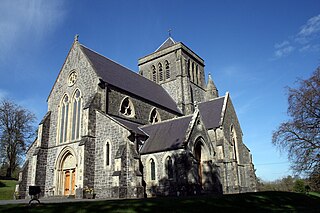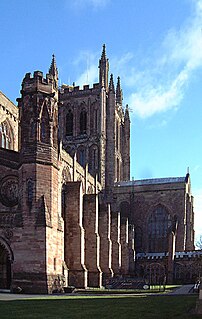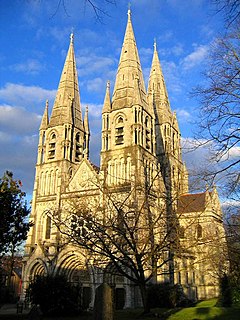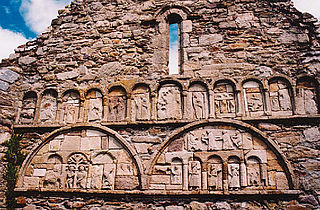The Bishop of Connor is an episcopal title which takes its name after the village of Connor in County Antrim, Northern Ireland. The title is currently used by the Church of Ireland, but in the Roman Catholic Church it has been united with another bishopric.

The Bishop of Kilmore is an episcopal title which takes its name after the parish of Kilmore, County Cavan in Ireland. In the Roman Catholic Church it remains a separate title, but in the Church of Ireland it has been united with other bishoprics.

The Bishop of Ferns is an episcopal title which takes its name after the village of Ferns in County Wexford, Ireland. In the Roman Catholic Church it remains a separate title, but in the Church of Ireland it has been united with other bishoprics.

The Diocese of Dromore is a Roman Catholic diocese in Northern Ireland. It is one of eight suffragan dioceses which are subject to the Metropolitan Archdiocese of Armagh.
The Bishop of Meath is an episcopal title which takes its name after the ancient Kingdom of Meath. In the Roman Catholic Church it remains as a separate title, but in the Church of Ireland it has been united with another bishopric.
The Bishop of Down and Connor is an episcopal title which takes its name from the town of Downpatrick and the village of Connor in Northern Ireland. The title is still used by the Roman Catholic Church, but in the Church of Ireland it has been modified into other bishoprics.

The Bishop of Down was an episcopal title which took its name from the town of Downpatrick in Northern Ireland. The bishop's seat (Cathedra) was located on the site of the present cathedral church of the Holy and Undivided Trinity in the Church of Ireland.

The Bishop of Limerick is an episcopal title which takes its name after the city of Limerick in the Province of Munster, Ireland. In the Roman Catholic Church it still continues as a separate title, but in the Church of Ireland it has been united with other bishoprics.

Hugh de Mapenor was a medieval Bishop of Hereford. Although educated and given the title of magister, or "master", the details of his schooling are unknown. Mapenor was a clerk for Giles de Braose, his predecessor as bishop. Later, Mapenor served as Dean of Hereford before being elected as bishop against the wishes of King John of England. During his short episcopate, he supported John's son and successor King Henry III of England, and was active in his diocese, as a number of surviving documents show. He also served as a diplomat for the king.
The Bishop of Kilfenora was a separate episcopal title which took its name after the village of Kilfenora in County Clare, in the Republic of Ireland. In both the Church of Ireland and the Roman Catholic Church, the title is now united with other bishoprics.
The Bishop of Ardfert and Aghadoe was an episcopal title which took its name after the village of Ardfert and townland of Aghadoe, both in County Kerry, Republic of Ireland.
The Bishop of Cork and Cloyne was an episcopal title which took its name after the city of Cork and the town of Cloyne in southern Ireland.

The Diocese of Cork, Cloyne and Ross, also referred to as the United Diocese of Cork, Cloyne and Ross is a diocese in the Church of Ireland. The diocese is in the ecclesiastical province of Dublin. It is the see of the Bishop of Cork, Cloyne and Ross, the result of a combination of bishoprics of Cork and Cloyne in 1429, Cork and Cloyne and Ross in 1583, the separation of Cork and Ross and Cloyne in 1660 and the re-combination of Cork and Ross and Cloyne in 1835.

The Diocese of Down and Dromore is a diocese of the Church of Ireland in the south east of Northern Ireland. It is in the ecclesiastical province of Armagh. The geographical remit of the diocese covers half of the City of Belfast to the east of the River Lagan and the part of County Armagh east of the River Bann and all of County Down.
The Bishop of Lismore was a separate episcopal title which took its name after the town of Lismore in County Waterford, Republic of Ireland.
The Bishop of Dromore is an episcopal title which takes its name after the market town of Dromore in County Down, Northern Ireland. In the Roman Catholic Church the title still continues as a separate bishopric, but in the Church of Ireland it has been united with other bishoprics.
The Bishop of Leighlin was a separate episcopal title which took its name after the small town of Old Leighlin in County Carlow, Republic of Ireland.

The Bishop of Glendalough was an episcopal title which took its name after the monastery at Glendalough in County Wicklow, Republic of Ireland. An Irish version of the place name, Glenndálocha, is now used for a titular see.
The Bishop of Mayo was an episcopal title which took its name after Mayo in Ireland. After the Reformation, the title was briefly used by the Church of Ireland until 1559 and by the Roman Catholic Church until 1631. With each denomination, the bishopric was united to the archbishopric of Tuam.

Declán of Ardmore, also called Déclán, was an early Irish saint of the Déisi Muman, who was remembered for having converted the Déisi in the late 5th century and for having founded the monastery of Ardmore in what is now Co. Waterford. The principal source for his life and cult is a Latin Life of the 12th century. Like Ailbe of Emly, Ciarán of Saigir and Abbán of Moyarney, Declán is presented as a Munster saint who preceded Saint Patrick in bringing Christianity to Ireland. He was regarded as a patron saint of the Déisi of East Munster.










